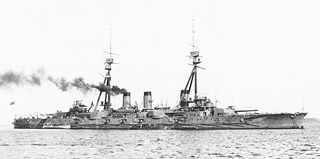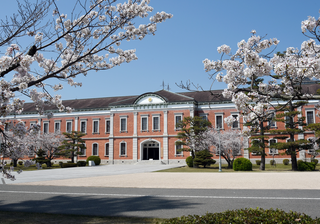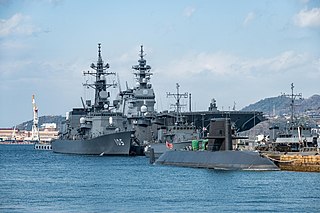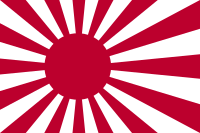
Kure is a city in Hiroshima Prefecture, Japan. As of 30 April 2023, the city had an estimated population of 208,024 in 106,616 households and a population density of 590 persons per km². The total area of the city is 352.80 square kilometres (136.22 sq mi). With a strong industrial and naval heritage, Kure hosts the second-oldest naval dockyard in Japan and remains an important base for the Japan Maritime Self-Defence Force.

Fusō was the lead ship of the two Fusō-class dreadnought battleships built for the Imperial Japanese Navy. Launched in 1914 and commissioned in 1915, she initially patrolled off the coast of China, playing no part in World War I. In 1923, she assisted survivors of the Great Kantō earthquake.

Hyūga was the second and last Ise-class battleship built for the Imperial Japanese Navy (IJN) during the 1910s. Although completed in 1918, she played no role in World War I. Hyūga supported Japanese forces in the early 1920s during the Siberian intervention in the Russian Civil War. In 1923, she assisted survivors of the Great Kantō earthquake. The ship was partially modernised in two stages in 1927–1928 and 1931–1932, during which her forward superstructure was rebuilt in the pagoda mast style. Hyūga was reconstructed in 1934–1936, improvements being made to her armour and propulsion machinery. Afterwards, she played a minor role in the Second Sino-Japanese War.

The Japan Coast Guard Academy (JCGA) is a university-level service academy established within the Ministry of Land, Infrastructure, Transport and Tourism for the purpose of training students to become Coast guard officers. It is located in Kure, Hiroshima prefecture.

Mutsu (陸奥) was the second and last Nagato-class dreadnought battleship built for the Imperial Japanese Navy (IJN) at the end of World War I. She was named after the province. In 1923 she carried supplies for the survivors of the Great Kantō earthquake. The ship was modernized in 1934–1936 with improvements to her armour and machinery, and a rebuilt superstructure in the pagoda mast style.

The Japan Maritime Self-Defense Force, abbreviated JMSDF, also simply known as the Japanese Navy, is the maritime warfare branch of the Japan Self-Defense Forces, tasked with the naval defense of Japan. The JMSDF was formed following the dissolution of the Imperial Japanese Navy (IJN) after World War II. The JMSDF has a fleet of 154 ships, 346 aircraft and 50,800 personnel.

Settsu (摂津) was the second and last of the Kawachi-class dreadnought battleships built for the Imperial Japanese Navy (IJN) in the first decade of the 20th century. Following the Japanese ship-naming conventions, Settsu was named after Settsu Province, now a part of Osaka prefecture. During World War I she bombarded German fortifications at Qingdao during the siege of Qingdao in 1914, but saw no other combat. She was placed in reserve in 1919 and was disarmed in 1922 in accordance with the terms of the Washington Naval Treaty.

The Imperial Japanese Naval College was a school established to train line officers for the Imperial Japanese Navy. It was originally located in Nagasaki, moved to Yokohama in 1866, and was relocated to Tsukiji, Tokyo in 1869. It moved to Etajima, Hiroshima in 1888. Students studied for three or four years, and upon graduation were ordered (warranted) as Midshipmen, commissioned to the rank of Ensign/Acting Sub-Lieutenant after a period of active duty and an overseas cruise. In 1943, a separate school for naval aviation was opened in Iwakuni, and in 1944, another naval aviation school was established in Maizuru. The academy was closed in 1945, when the Imperial Japanese Navy was abolished. The Naval Academy Etajima opened in 1956 and the site now serves as the location for Officer Candidate School of the Japan Maritime Self-Defense Force.

JDS Wakaba (DE-261) was the former Imperial Japanese Navy ship Nashi, an escort destroyer of the Tachibana sub-class of the Matsu class built for the Imperial Japanese Navy during the final stages of World War II. Nashi was sunk in July 1945, but salvaged in 1954 and refitted to join the Japan Maritime Self-Defense Force in 1956 as Wakaba, later being utilised as a radar trials ship, but stricken in 1971 and scrapped in 1972-1973.

Mitsumi Shimizu was a vice admiral in the Imperial Japanese Navy in World War II.
Kure Naval District was the second of four main administrative districts of the pre-war Imperial Japanese Navy. Its territory included the Inland Sea of Japan and the Pacific coasts of southern Honshū from Wakayama to Yamaguchi prefectures, eastern and northern Kyūshū and Shikoku.

Kure Naval Arsenal was one of four principal naval shipyards owned and operated by the Imperial Japanese Navy.

The attacks on Kure and the Inland Sea by United States and British naval aircraft in late July 1945 sank most of the surviving large warships of the Imperial Japanese Navy (IJN). The United States Third Fleet's attacks on Kure Naval Arsenal and nearby ports on 24, 25, and 28 July sank an aircraft carrier, three battleships, five cruisers, and several smaller warships. During the same period the British Pacific Fleet attacked other targets in the Inland Sea region and sank two escort ships and several smaller vessels as well as damaging an escort carrier.
This is a list of Imperial Japanese Navy bases and facilities
Major Shizuo Fukui was a Japanese author, photographer, editor, and Imperial Japanese Naval and Japanese Coast Guard officer with the rank of lieutenant commander. He was most famous for his comprehensive books of all combatant vessels and minor miscellaneous vessels in the Japanese Navy during World War II and postwar Japan. His third son Takeo Fukui was President of Honda R&D and Honda.

The Mine Warfare Force belonged to the minesweeping force for the self-defense fleet of the Maritime Self-Defense Forces. Its main task is to lay naval mines in the event of an emergency, and it also helps to dispose of mines installed during World War II.

Vice Admiral Mitsugu Ihara was a Japanese naval officer who served in both the Imperial Japanese Navy from 1920 to 1945 and the Japanese Maritime Self Defence Force (JMSDF) from 1954 to 1960. He was the third Chief of Staff of the JMSDF succeeding Yasumaro Kiguchi. In 1961, he was succeeded by Nobuo Fukuchi.

Zenshiro Hoshina was a Japanese naval officer and politician. The final rank is Vice Admiral of the Navy. After serving as a member of the House of Representatives for four terms, he became chairman of the Japan Defense Association.

The Yokosuka Naval Base, also simply known as the JMSDF Yokosuka Naval Base, is a group of ports and land facilities of the Japan Maritime Self-Defense Force (JMSDF), which are scattered in multiple districts of Yokosuka City, Kanagawa Prefecture, and where the Yokosuka District Force, etc. are located. It is not officially called a base, but it is used as a common name. The base sits alongside the United States Fleet Activities Yokosuka.

The Kure Naval Base, also simply known as the JMSDF Kure Naval Base, is a group of ports and land facilities of the Japan Maritime Self-Defense Force (JMSDF), which are scattered in multiple districts of Kure City, Hiroshima, and where the JMSDF Kure District, etc. are located.



















